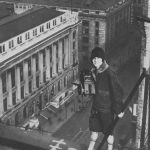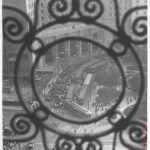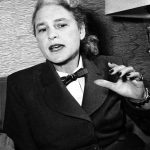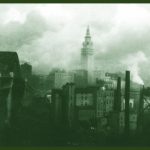| 1 | Woman of Steel |
| 2 | Margaret Bourke-White History Making Photojournalist and Social Activist |
| 3 | Cleveland’s Towering Image |
Category: Margaret Bourke-White
{gallery}the_twenties/bourke-white{/gallery}
Woman of Steel
Article about Margaret Bourke-White from American Heritage Magazine
WOMAN OF STEEL
Margaret Bourke-White made industrial photography a powerful art form in the 1920s and 1930s
Some say that traditional religion died in the nineteenth century and was supplanted in the twentieth by worship of the machine. A curious reverence for machinery did spring up in the first decade of this century, principally in Europe; in the United States the new “religion” did not make a strong showing until about 1927, despite the fact that expanding technology and the shift to an urban economy had transformed America into the most highly industrialized nation in the world. In the spring of 1927 the catalog for a New York show called “Machine-Age Exposition” declared: “Is not the machine today the most exuberant symbol of the mystery of human creation? Is it not the new mythical deity which weaves the legends and histories of the contemporary human drama? The Machine in its practical and material function comes to have today in human concepts and thoughts the significance of an ideal and spiritual inspiration.”
The nation had been fascinated by machines even before it learned to worship them. Pictures of industry were popular in the first quarter of the century, but industrial photography had not yet become a fine art. During the first two decades, Americans bought thousands of stereoscope slides of factories crammed with the new means of production; the pictures were straightforward, explanatory, factual, and uninspired. Then, around 1920, a few American painters and photographers, especially such artists as Charles Sheeler, Charles Demuth, and Ralston Crawford, in a group known as the Precisionists, began to create an artistic vocabulary capable of speaking for the machine age. Demuth titled his painting of grain elevators My Egypt, an ironic comparison of American monuments to the pyramids. The photographer Paul Strand was so intrigued with the mechanics of his movie camera that he opened it up and took close-up still photographs of its precision-turned interior.In the fall of that year, Margaret Bourke-White, newly graduated from Cornell, took her camera to the teeming industrial parks of Cleveland and began to photograph the smokestacks, freight cars, squat factory buildings, and bleak, mineral vistas of the industrial era. She was not the first to photograph machines, but her approach made industry so convincingly beautiful, dramatic, and romantic that she created the icons for America’s most recent popular devotion.
Bourke-White’s vision of industry was altogether different. Her camera concentrated on stark contrasts of flame and darkness; on the complex spaces of factories crowded with equipment; on the dynamic, repetitive forms of mass production. To Bourke-White, industry was a dramatic stage for the play of mechanical process, vivid light, and strong pattern. The photographs she took for advertisements and for Fortune magazine had a kind of cinematic grandeur that convinced her public that a new beauty had been born with the rise of technology. And at a time when salaried managers were taking over from older corporate entrepreneurs like Carnegie and Frick, Bourke-White’s grand, artistic images provided a new and efficient means of establishing a prestigious corporate identity.Late in 1927, at almost the moment Margaret Bourke-White began her industrial work, Henry Ford commissioned Sheeler to photograph the Ford River Rouge plant, not for specific advertising purposes but as a record of American technological invention. Sheeler saw the River Rouge as a great web of pure, sharp, static forms, a vast display of mechanical potential forever stilled by his photographs.
Bourke-White herself was convinced she was creating the only art for her time.“Any important art coming out of the industrial age,” she said, “will draw inspiration from industry, because industry is alive and vital. The beauty of industry lies in its truth and simplicity; every line is essential and therefore beautiful.”The idea that industrial forms could be art suited a general belief that technology and business would raise the world to greater heights. Henry Ford himself gave the “religion of the machine” its credo: “Machinery,” he said, “is the new Messiah.” By the late twenties Americans were prepared to believe that engineers were a new breed of artist who had spawned a new aesthetic. Within months after Bourke-White took her first industrial photographs, in the Otis Steel plant in Cleveland, the Associated Press headlined the exalted status of her pictures: GIRL’S PHOTOGRAPHS OF STEEL MANUFACTURE HAILED AS NEW ART.
As it happened, she had in her hands the perfect instrument for recording the essential dignity of mechanical invention. In 1930 the New York Times art critic wrote: “Photography is the machine-age art par excellence. The moving picture and the snap-shot mark the tempo of our time. The mass production implicit in the photographic process is economically modern.”
The new art began to appear everywhere, in ads, in Sunday rotogravure sections, in museums. Cleveland’s biggest bank enclosed its quarterly dividend checks in folders adorned with Bourke-White’s photographs of the steel industry. But the camera’s most lasting liaison with industry occurred in the pages of Fortune, which commenced publication mere months after the stock market crashed. Fortune’s luxurious format, handsome photographs, and emphasis on industry reassured America each month that the power of technology could pull the nation through any crisis. During the Depression, big business needed precisely the kind of symbolic, awe-inspiring photographs Bourke-White could produce on demand, for although her pictures did not sell nuts and bolts, they persuasively portrayed industry as reliable, powerful, and forward-looking.
In Fortune’s first issue Bourke-White was the only photographer with a credit line. She remained the magazine’s star for several years, and her name became synon1 ymous in the public mind with industrial photography. She had been hired when the magazine was still in the planning stages; at that point a friend remarked that if the magazine failed, she’d be known as “Miss Fortune.”
If people were surprised to discover that grain-elevator pipes and gigantic rolls of wet paper had artistic value, they were even more startled to learn that the photographer was an attractive woman in her twenties who wore fashionable clothes and bobbed her hair. What’s more, the “girl photographer” went to immense lengths to define the beauties of technology, learning to walk across scaffolds eight hundred feet above the sidewalk, moving in so close to the molten metal in a steel factory that the varnish on her camera blistered. In her diary, she wrote about one photograph, “I am glad that it is good, because it was so exciting to go up and take it through the carbon monoxide gas on the top of the coke oven, with my guide posted at the foot of the steps to run up and catch me if I should keel over.”
In the early stages of Bourke-White’s career, as in the early stages of machine art in general, the machine was clearly the hero, while the worker played a subsidiary role or remained offstage. But by the mid-thirties, even though Americans remained fascinated with technology, the Depression had compelled the country to pay attention to the plight of human beings. Margaret Bourke-White trained her lens more and more often on the worker behind the machine, and soon she began to try her hand at photojournalism, a genre always marked by a strong narrative interest in human stories and human events. When the premiere issue of Life, America’s first great picture magazine, reached the newsstands in 1936, Bourke-White’s photographs summed up the country’s preoccupations. On the cover her picture of Fort Peck Dam vaunted the majestic beauty of advanced engineering; in the lead story her depiction of the Fort Peck construction workers dancing, drinking, and playing the fiddle carried the implied message that the tough, plucky workingman and -woman could win the economic war.
From time to time Bourke-White still took industrial photographs, most notably in a story on women steel-workers in World War H. Other photographers over the years would build on her theatrical, powerful style with its romantic light and modernist abstractions, a style that established the ground rules for industrial photography for years. But by the Second World War the country’s passionate devotion to technology had cooled down, the camera had been drafted to document a war, and the glory days of industrial photography had faded away with the exaggerated notion of machinery as a new Messiah. Bourke-White went on to photograph the German bombardment of Moscow, the liberation of Buchenwald, the partition of India, and the other major events of an era that still depended on technology but no longer chose to worship its machines.
Vicki Goldberg is the author of Margaret Bourke-White: A Biography (Harper & Row, 1986).
Margaret Bourke-White History Making Photojournalist and Social Activist
Article about Margaret Bourke-White written by Patrick Cox, Ph.D
| Margaret Bourke-White History Making Photojournalist and Social Activist January 2003 |
 |
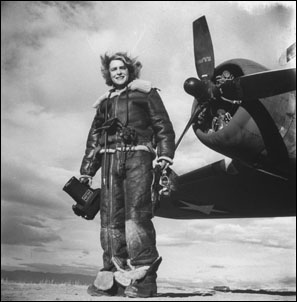
In the beginning, there was Margaret Bourke-White (1904-1971). One of the trailblazers in twentieth century photojournalism, Bourke-White played an historic role in media and women’s history. As a woman photojournalist, her reputation rivaled Ida Tarbell, the muckraker who exposed the abuses of Standard Oil, in its impact on modern journalism. Bourke-White became an internationally famous photographer and holds many “firsts” in her portfolio. In addition to her professional contributions, her activism on behalf of the poor and underprivileged throughout the world places her among the foremost humanitarians of the century.
When Bourke-White entered the field of journalism in the 1920’s, few women participated as professional journalists or photographers. A handful of women photographers, Frances Benjamin Johnson, Jessie Tarbox Beals and a few others represented an earlier generation whose photos appeared in newspapers and magazines in the early twentieth century. Although social and vocational roles expanded in the 1920’s, women lived in an era of rigid expectations. Female journalists remained mostly confined to the women’s and society pages of the metropolitan newspapers. As more women entered the profession in the 1920’s and 1930’s, a few doors began to open for women to assume the tasks traditionally taken by male reporters and photographers. Margaret Bourke-White rushed through this door to become a leading figure in the profession.
With the encouragement and guidance of her father, Bourke-White began taking photographs at an early age. She completed college at Cornell and opened her own photographic studio in Cleveland. She ventured into the fiery steel plants where women never ventured. The fiery cauldrons, molten steel, and showers of sparks depicted the industrial might of the nation. The dynamic series of industrial photos in the 1920’s caught the attention of Henry Luce. The well-known publisher hired Bourke-White as the first photographer at Fortune magazine in 1929. Her first assignment in the premier issue provided a physical and a professional challenge – covering the Swift hog processing plant – a site as challenging as the steel mills with its pungent air, bloody working conditions and where one misstep could prove fatal. She went to Russia and provided the first extensive photo series on Soviet Union. Dams, factories, farms, workers, farmers and every day life in Stalin’s communist state came to life for the first time to viewers in the west.
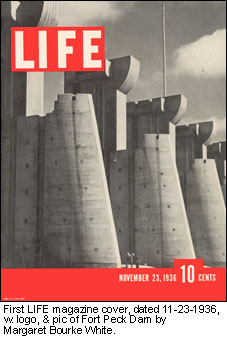 Following her success at Fortune, Bourke-White became one of the first group of photographers hired by Life. Her photo graced the inaugural issue of the famous magazine. Her 1936 black and white cover photo of a massive dam validated her photography credentials in a field still dominated by men. The photo issued a statement that technology and American ability could overcome the economic depression of the 1930’s. During her years at Life, the magazine grew to national prominence thanks to the brilliant photos of Bourke-White and her colleagues.
Following her success at Fortune, Bourke-White became one of the first group of photographers hired by Life. Her photo graced the inaugural issue of the famous magazine. Her 1936 black and white cover photo of a massive dam validated her photography credentials in a field still dominated by men. The photo issued a statement that technology and American ability could overcome the economic depression of the 1930’s. During her years at Life, the magazine grew to national prominence thanks to the brilliant photos of Bourke-White and her colleagues.
During this period Bourke-White teamed with the popular southern novelist Erskine Caldwell. One of the most widely read authors of the twentieth century, Caldwell is best known for his works God’s Little Acre and Tobacco Road. Working in the poverty-stricken rural areas of the American South, the dynamic team published You Have Seen Their Faces. The pictures of poverty and discrimination in the south rivaled the urban privation photos of Jacob Riis. The gaunt faces revealed the abysmal social and economic conditions of the Depression-era south. Their work received acclaim but was criticized for its bias and exposure of racism in the south. Years after their automobile tour of the south, Caldwell lauded Bourke-White. “She was in charge of everything, manipulating people and telling them where to sit and were to look and what not. She was very adept at being able to direct people,” he said in an interview. Bourke-White and Caldwell were the only journalists in the Soviet Union when the German Army invaded in the summer of 1941. The couple married in 1939 but their relationship ended during World War II.
During World War II, Bourke-White became one of a stalwart group of women correspondents who covered the war from the front lines. Her book They Called It Purple Heart Valley provided a narrative and photographic study of the war in Europe in 1944. She took photos of foot soldiers and generals, victims of the war and its destruction. She slogged through the mud and heat and went everywhere from the front lines to the hospital wards. As she accompanied troops in the Italian campaign, Bourke-White wrote of one encounter. “Right beneath my feet, at the foot of the cliff, was a row of howitzers sending out sporadic darts of flame. Since I was so high up and so far forward, most of our heavies were in back of me, and I could look over the hills from which we had come and see the muzzle flashes of friendly guns, looking as if people were lighting cigarettes all over the landscape.”
In one of her most difficult tasks, Bourke-White accompanied U.S. troops as they liberated the Buchenwald Concentration Camp in 1945. With portraits of starving prisoners and dead bodies heaped one upon another, she documented some of the worst horrors of the Nazi regime. Even with government censorship, Bourke-White and her fellow photographers and journalists gave Americans an unprecedented view of the global conflict and the human suffering the war created.
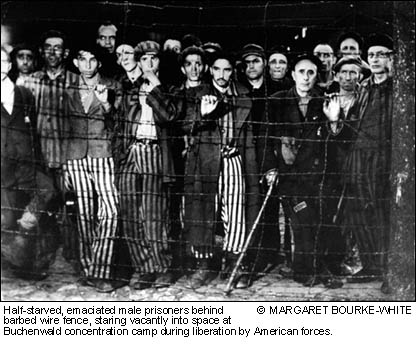
After the war, Bourke-White continued her worldwide photography and focused much of her work on humanitarian issues. She covered Gandhi’s campaign of nonviolence in India and African mine workers and apartheid in South Africa. Carl Mydans of Life said, “Margaret Bourke-White’s social awareness was clear and obvious. All the editors at the magazine were aware of her commitment to social causes.” She joined with other artists to form the American Artists’ Congress that advocated state and public support for the arts and fought discrimination. The FBI began collecting information on her political activity in the 1930’s. During the McCarthy era, she became the subject of scrutiny for her involvement with organizations that promoted civil and political rights. She received criticism by the House Un-American Activities Committee and newspaper columnists for her work on You Have Seen Their Faces and other publications she authored. As she wrote in the Nation magazine on February 19, 1936, “It is my own conviction that defense of the economic needs, as well as their liberty of artistic expression, will inevitably draw them closer to the struggle of the great masses of American people for security and the abundant life which they are more than anxious to earn by productive work.”
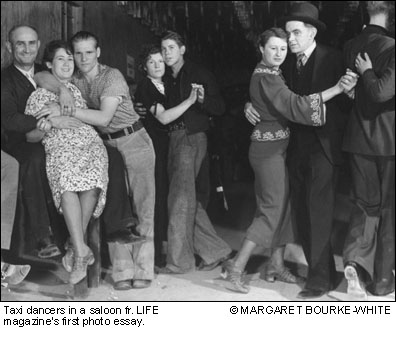
Bourke-White developed Parkinson’s disease in 1956. After the diagnosis, she spent six years writing her autobiography. Portrait of Myself was published in 1963. She continued taking photographs and writing until her death in 1971. The most recent study of her career is Vicki Goldberg’s Margaret Bourke-White: a biography. A collection of her works are in The Photographs of Margaret Bourke-White, edited by Sean Callahan. A recent movie entitled “Double Exposure” chronicled her early life and years with Erskine Caldwell. Margaret Bourke-White combined professional skills and a socially responsive philosophy that made her one of the 100 most influential women of twentieth century.
© Patrick Cox, Ph.D
Assistant Director, Center for American History
University of Texas at Austin
pcox@mail.utexas.edu
Dr. Cox authored the biography on the late U.S. Senator Ralph W. Yarborough (D-Texas) published by the University of Texas Press. Ralph W. Yarborough: The People’s Senator, was a finalist in the Western Writers Association and the Robert Kennedy Foundation Book Award for 2002
Cleveland’s Towering Image
Cleveland Magazine article about Margaret Bourke-White, famous photographer who made Cleveland her home for a while in the late 1920s and early 1930s
The link is here

